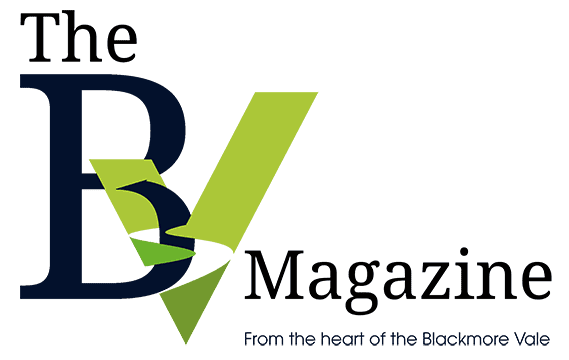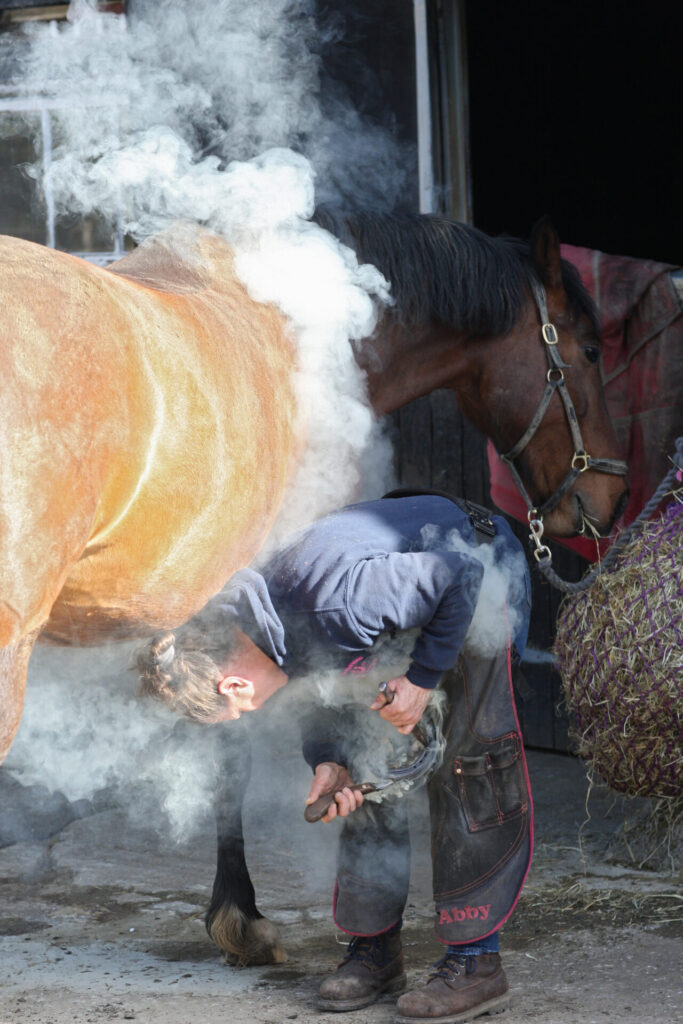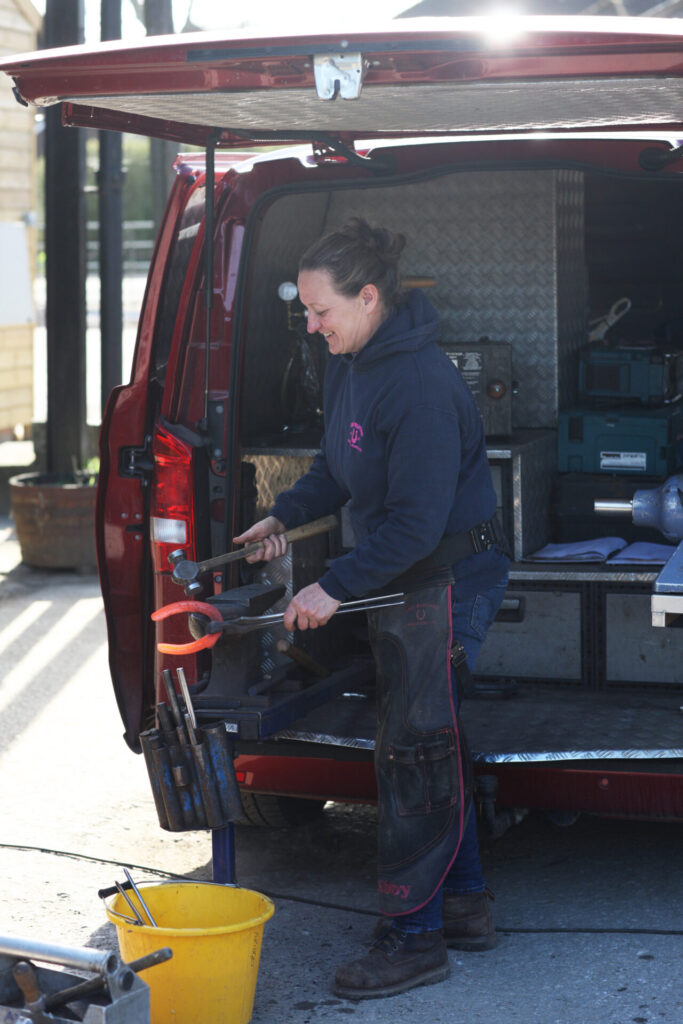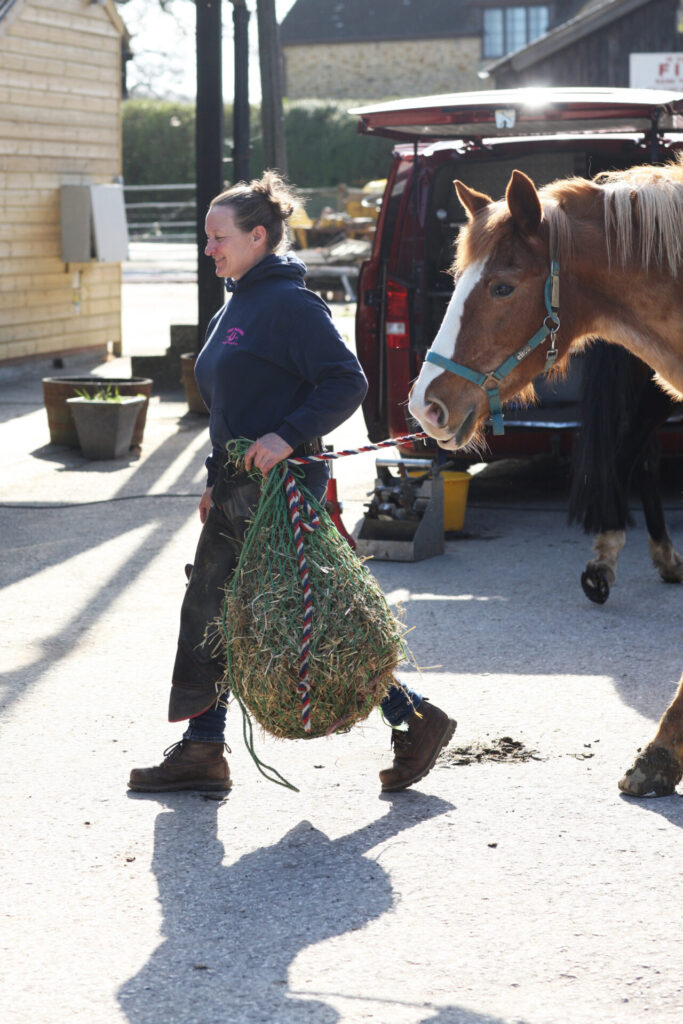Just don’t call her a female farrier – Abby Bunyard never set out to break barriers, she just forged her own path by refusing to accept them
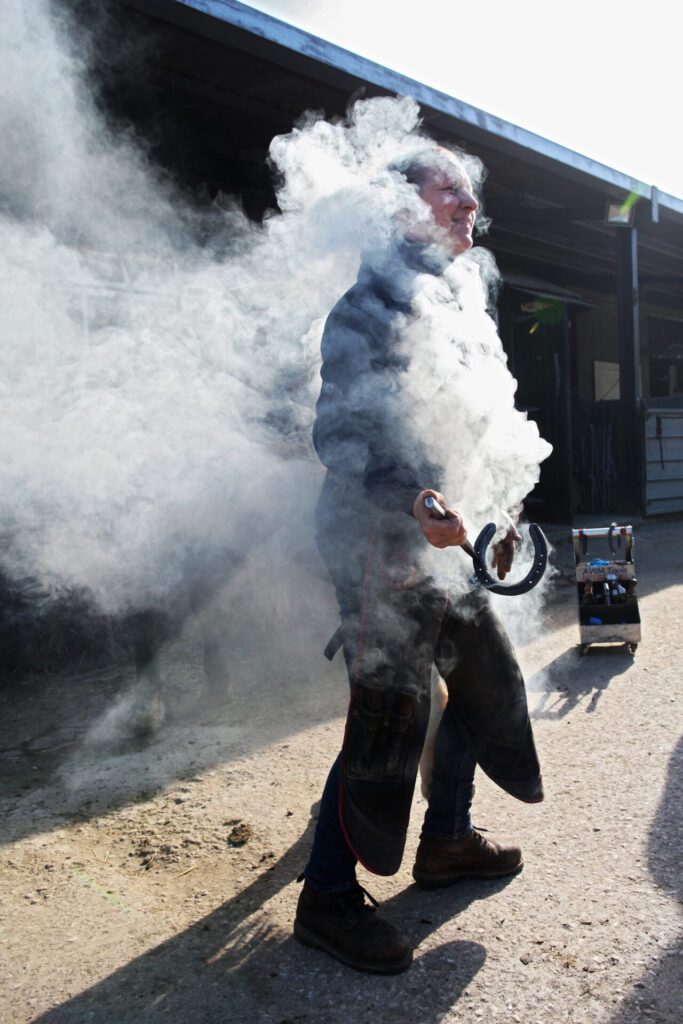
All images © Courtenay Hitchcock
Not many people can say they knew their calling at six years old – fewer still can say they stuck to it. But Abby Bunyard isn’t most people.
‘I was lucky that when I was younger, my sister used to ride,’ she says. ‘She’s four years older, so I was always dragged along, and was always around ponies. The farrier at the yard asked me what I was going to be when I grew up, and I told him I was going to be a farrier. He said, “Come find me when you’re big enough.” So I did.’
Dorset-born and raised, Abby grew up in Stalbridge while her father, a Navy man, ‘floated around the world’, as she says. ‘Mum and Dad had an agreement: it was his job, and the kids would stay rooted. Every time Dad came home, it was like Christmas. Sometimes we got four a year! We were lucky.’
Those early years around ponies lit the fuse. By the time she left her all-girls school – which viewed her ambitions with what we might politely call raised eyebrows – she was already fixed on her goal.
‘It wasn’t a career they really understood,’ she says. ‘But I’m fairly bloody-minded, and people telling me I couldn’t do it just drove me towards it, really. It was my passion. It was what I wanted to do. I wanted to be able to make a difference in an animal’s life – the biomechanics, the structure … I could see all the things that we humans were asking of these animals and I thought we needed to give back. The more comfortable we can make them, and the more efficient in their work we could make them, the better they would be and the happier they’d be.’
The UK is the only country where farriers must legally be qualified and registered, so she entered the UK’s formal apprenticeship system. At the time, the Hereford School of Farriery was the only college offering the training. Abby joined a class of 34 of whom only two were women – and the other only lasted a year. ‘She was Spanish: away from home in a male-dominated industry, doing a hard physical job in a different language … it was tough.’
Abby, however, didn’t flinch.
‘I definitely had to work twice as hard. But I had an exceptional boss – so many people told him taking me on was a terrible mistake, but the more people told him that, the more determined he was!’
Even so, it took time to find her place. ‘It took a week before anyone even spoke to us at college. I don’t think they knew what I was. Was I a threat? A joke? A random? No idea. But I went into it to become a farrier. That’s all that mattered.’
The day she walked on stage to receive her qualification from the Worshipful Company of Farriers, she received a standing ovation. ‘I cracked them,’ she says.
In 2025, things are different: ‘It’s 100 times better now.’
But Abby hasn’t once in her 30-year career considered quitting. ‘No. I genuinely haven’t done a day’s work in my life. I get up and do my hobby. I’m a farrier. That’s it. It’s a way of life. I adore it.’
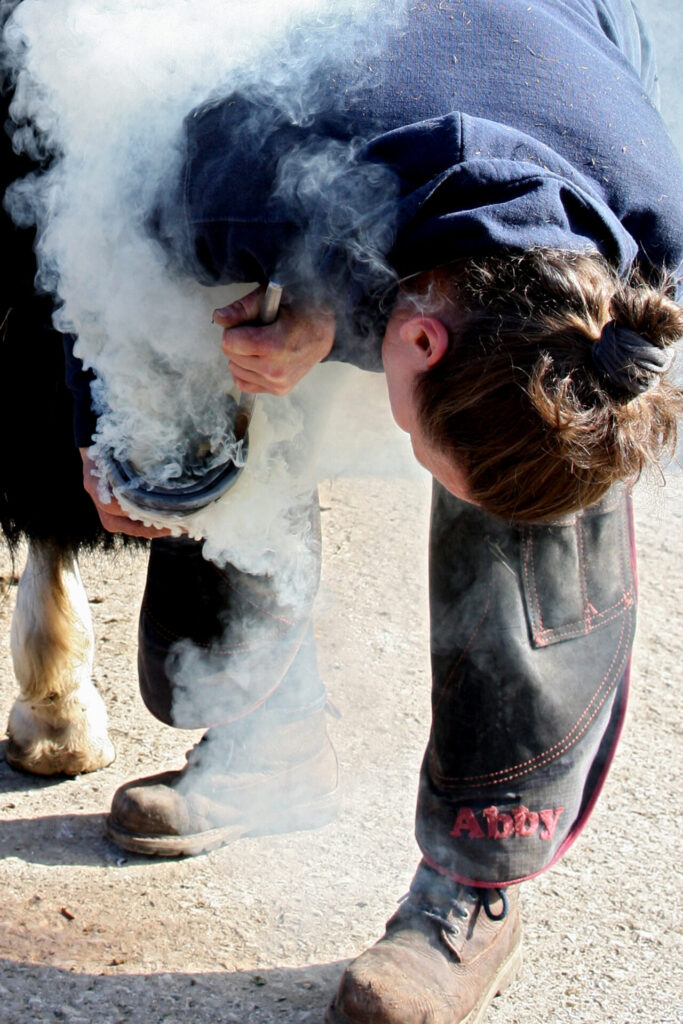
The day job
There’s no such thing, Abby says, as a normal farrier’s day: ‘I have absolutely no idea where we start and where we end! I train apprentices – someone gave me a chance, so I owe it forward. We get in the truck at 7.15am, and we laugh all day. We tag team so no one takes all the strain, and each horse we shoe, we discuss. Nothing is ever shod the same – it’s individual to the animal’s needs at that point in time. What needs to be done today might not be what’s needed in four weeks’ time.
‘The phone starts going Sunday night – “Any chance?” or “I forgot to book in…” or “can you just …” Monday morning the trucks are stocked and you have your list. But though you’ve got the horses’ names, you don’t know what’s changed in the last four to six weeks. Has it done more work? Less? If it has done less work than normal, why? Is the client OK? It’s not just about the horse. While you’re shoeing the horse, if the shoe pattern or wear has changed, you assess why is that changed? What has changed? Why has it changed? Was it changed conformationally? Is it uncomfortable due to biomechanical disruption? Every horse is unique, and each one demands thoughtful, individualised attention‘
But it’s never just about the horse. You walk onto a yard and say, “Hi, how are you?” and that starts the whole job.
Someone tells you Aunt Hilda’s died or the kids are sick or work’s gone crazy, and you suddenly know why the horse hasn’t been ridden as much or why its wear pattern is different.
You have to be fluid. You’re a farrier, but also a counsellor, a mind reader, a biomechanics geek. It’s holistic. It’s art.’
And then there was Edna
‘The best thing about this job is the difference I make,’ she says. ‘Big or small. When you walk a horse up and see it landing laterally – putting more medial strain on, because it will have a secondary medial landing – but if you then shoe that horse and walk it up and it lands flat, the entire limb or biomechanics of that animal are now in tune. I’ve made a massive difference … What’s more important? The laminitic pony that’s keeping a child with cancer alive because they can see their pony, and it’s just got to be okay? … or the not-100-per-cent-conformationally-sound animal that’s got to stay sound through a five star event?
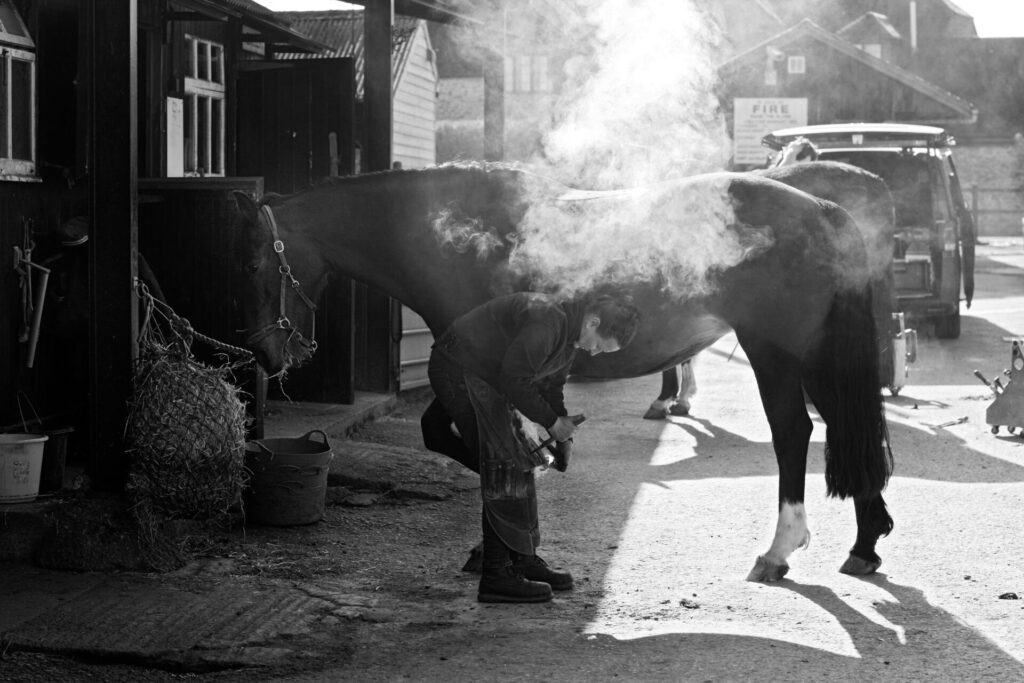
© Courtenay Hitchcock
All of those things matter. You’re not just treating the animal. You’re helping the person attached to it stay afloat.’
Sometimes it’s about the rider. Sometimes, it’s about the horse … and sometimes, it’s both.
‘There’s an older lady I visit, I do trims on her elderly pony. She always comes out with a teapot on a silver tray, proper biscuits … you can’t miss that trim. I cannot miss that trim. Because she gets up every day for that pony.’
One of Abby’s most memorable cases was Edna the injured pony: ‘Edna was a massive achievement. She got her rug caught in the fillet strings, and it severed through part of a deep digital flexor tendon. The owner just didn’t have a pile of spare money to spend on it, so my apprentice and I fabricated a pattern bar shoe, and the clients kept her in the box for six months. There really wasn’t much hope for her … but now, she’s out doing Pony Club stuff! We didn’t do it all by the book, but the owners listened to us, and it was such a great result.’
Be the best me
Today, Abby is not only a highly respected working farrier, but president of the British Farriers and Blacksmiths Association – the first woman ever to hold the title. ‘I didn’t go in to become president,’ she says. ‘I just realised one day I was sitting around grumbling about things I didn’t understand. So I decided to get involved. The more I learned, the more I realised what the Association could do. Soon I was treasurer, and the Association needed help getting back on its feet.
As treasurer, with a group of 12 other people, I made a hell of a difference. It was fantastic. And then I was made vice president … and when they put the president’s chain on at the AGM, the weight of that … I just thought, “Oh my God. What, what have I done?” I could feel the weight of its history.’
The president’s chain is 125 years old, and has the name of the founder of the BFBA engraved on it, as well as every president since. One year in and Abby is already making an impact: she is determined that the Association is the backbone and strength of leading the industry, and is pushing for greater inclusivity, accessibility and openness. Abby has never identified herself as a ‘woman in a man’s world’ And she resists being labelled a ‘female farrier’. ‘That pisses me off,’ she says. ‘I’m not a female farrier.
‘At no point – aged six, 14, 21, 32 – have I thought I was a female farrier. I’m a farrier. I don’t want to be the best female anything. I want to be the best me. That’s what matters.’
Being a farrier is so much more than shoes on horses. It’s also anatomy, diagnostics, mental health … and for Abby it’s long-haul travel too. The British Association is the crème de la crème of the farriery world and she has lectured on and shod horses all over the globe – Belgium, Geneva, Australia, New Zealand and the US.
She is currently working toward the highest professional qualification in her field: the Worshipful Company of Farriers Fellowship. There are only 52 fellows in the world. Fewer than a dozen are women, and none, until now, from Dorset.
‘It’s not a doctorate, but it’s the pinnacle in our profession. I’ve done the practical, I’ve just got the thesis to finish. It’s a whole new learning curve – writing isn’t my comfort zone – but I strive. I strive. I can’t see how I can train apprentices without continuing to learn myself. Otherwise you remain stagnant. And that is not good for animal welfare.’

Eyes wide open
And she’s not done yet. Abby is also the driving force behind Focus. A decade ago, it was an international farriery competition with three gazebos and a burger van. Held at Stoneleigh, home of the BFBA, for 42 years, Abby says every farrier in the world wants to compete there: ‘It’s the farriers’ mothership. And now we have 18 international teams of farriers, the best in the world, competing to be the international winner. Alongside that, it’s now the biggest international educational trade fair in the world. We have about 70 trade stands, a lecture theatre, a demo area, a members’ area … We had 1,800 people through the door last year – bear in mind, there’s only 2,500 farriers in the whole of the UK. I stopped in the doorway, just for a second, and looked around, soaking it up. The noise, the energy – it was bloody epic. That was our team … We built that.’
So what advice would Abby give someone considering farriery?
‘Eyes wide open. It’s hard graft. But it’s rewarding beyond words. You learn every day. The skills are vast – the science, the communication, the precision. And the life it gives you is incredible. You’re not stuck in an office. You’re outside, doing something real. And yes – you can make a good living. The United Kingdom’s farriery qualification will allow you to shoe all over the world. But it’s not a nine-to-five. It’s a total way of life.’
Abby’s already thinking about the next client, the next horse, the next puzzle to solve. For her, it’s not about being the first, or the best, or the most awarded. It’s about doing the job – and doing it properly.
Top tip for horse owners?
‘Pick out your horse’s feet. Twice a day! Regardless of where they have been. Animal welfare. That’s my hot tip.’
Abby
